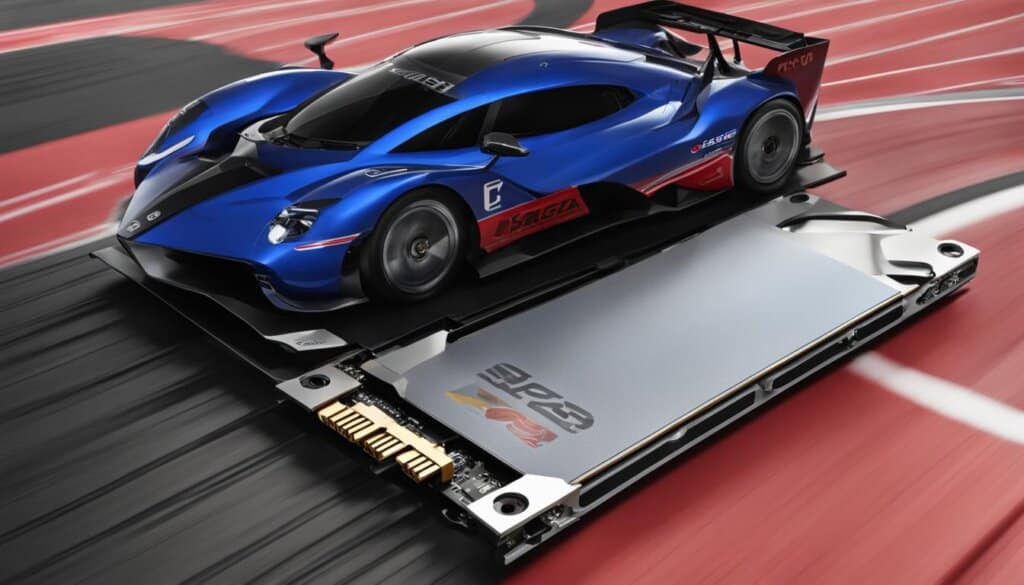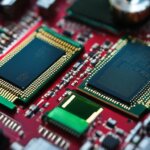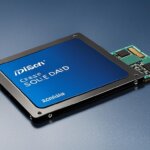Table of Contents
A solid-state drive, or SSD, is a type of storage device that replaces traditional hard disk drives (HDDs) in computers. It uses solid-state flash memory to store data, offering faster read/write speeds and improved performance compared to HDDs. SSDs have no moving parts like HDDs, making them more durable and reliable. They are used in various devices, including PCs, laptops, smartphones, and tablets. However, they tend to be more expensive than HDDs.
How do SSDs work?
When it comes to understanding how SSDs work, it’s all about flash memory. SSDs, or solid-state drives, read and write data using interconnected flash memory chips. These chips utilize floating gate transistors (FGTs) to hold an electrical charge, which represents the data stored on the drive. Each FGT holds a single bit of data, designated as a 1 or 0.
Unlike traditional hard disk drives (HDDs), which rely on spinning platters and mechanical read/write heads, SSDs have no moving parts. This makes them more durable, reliable, and resistant to shocks and vibrations.
SSDs can access data at a consistent speed, but the process of writing data is slightly different. To write data to an SSD, it must utilize empty blocks. This means that when data is deleted or modified, the SSD doesn’t immediately overwrite the existing data. Instead, it marks the blocks as empty and waits for new data to be written.
SSDs use a type of flash memory called NAND flash memory. NAND flash memory is a non-volatile type of memory, meaning it retains data even when power is removed. It’s named after the logic gate called the “NAND gate,” which forms the basic building block of the memory cell.
There are different types of NAND flash memory, each with its own advantages and trade-offs. These include Single-Level Cells (SLCs), which store one bit of data per cell and offer the highest performance and endurance; Multi-Level Cells (MLCs), which store multiple bits per cell and provide a good balance between cost and performance; and Triple-Level Cells (TLCs), which store three bits per cell and offer higher storage capacity but lower endurance.
To summarize, SSDs rely on flash memory, specifically NAND flash memory, to store and retrieve data. Their lack of moving parts makes them faster, more durable, and more reliable than traditional HDDs, offering improved performance for various devices and applications.
Understanding how SSDs work is crucial for anyone looking to upgrade their storage or build a new system. The next section will delve into the major features of SSDs, uncovering additional advantages and insights into this revolutionary storage technology.
Major features of SSDs
SSDs, or solid-state drives, offer several key features that set them apart from traditional HDDs (hard disk drives). Let’s explore some of the major features that make SSDs a popular choice for storage:
- Durability: One of the standout features of SSDs is their durability. Unlike HDDs, which have moving parts that can wear out over time, SSDs have no mechanical components. This makes them more resistant to shock, vibration, and physical damage, ensuring your data remains safe even in rugged environments.
- Power consumption: SSDs are known for their energy efficiency. They consume significantly less power compared to HDDs, making them an ideal choice for portable devices such as laptops and smartphones. With lower power consumption, you can enjoy longer battery life and reduce your overall energy costs.
- Size: SSDs are compact and come in various form factors, allowing for more flexibility in device design. Whether you need to install an SSD in a desktop computer, laptop, or ultrabook, you can find a size that fits your specific requirements. This compactness also enables SSDs to be used in smaller devices, such as tablets and wearable technology.
- Predictive analytics: Another notable feature of SSDs is their inclusion of predictive analytics in their controller software. This advanced technology helps identify potential drive failures before they happen, allowing you to take proactive measures to protect your data. These predictive analytics algorithms monitor various parameters, such as temperature, usage patterns, and error rates, providing early warnings to prevent data loss.
In summary, the major features of SSDs include their durability, low power consumption, compact size, and predictive analytics capabilities. These features make SSDs a reliable, efficient, and future-proof choice for storing and accessing your data.
Advantages of SSDs
When it comes to storage devices, solid-state drives (SSDs) offer several advantages over traditional hard disk drives (HDDs). Let’s explore why SSDs are increasingly becoming the preferred choice for many users.
Faster Read/Write Speeds
One of the key advantages of SSDs is their faster read/write speeds. Unlike HDDs, which rely on spinning disks and mechanical arms to access data, SSDs use flash memory. This allows them to retrieve and store data at a much quicker rate, resulting in improved overall system performance.
Quicker Boot Times
Thanks to their faster read/write speeds, SSDs enable quicker boot times. Whether you’re powering on your laptop or starting up your gaming PC, an SSD can significantly reduce the waiting time and get you up and running in no time.
Durability and Shock Resistance
SSDs have no moving parts, which makes them more durable and shock-resistant compared to HDDs. Their solid-state design means they are less susceptible to physical damage from accidental drops or bumps, making them ideal for portable devices like laptops and tablets.
Lower Power Consumption
In addition to their speed and durability, SSDs also boast lower power consumption. They require less energy to operate, making them more energy-efficient and contributing to longer battery life in laptops and mobile devices.
Compact Size and Form Factor Options
SSDs have a smaller physical footprint compared to HDDs, allowing for more flexibility in device design. This smaller size is especially beneficial for ultrabooks and compact desktop PCs where space is limited. Moreover, SSDs come in various form factors, such as the popular 2.5-inch drives, M.2, and U.2, offering compatibility with different hardware configurations.

Disadvantages of SSDs
Although solid-state drives (SSDs) offer numerous advantages, they are not without their drawbacks. In this section, we will explore the disadvantages associated with SSDs, including cost, life expectancy, and performance degradation.
Cost
One of the main disadvantages of SSDs is their higher cost compared to traditional hard disk drives (HDDs). While the price gap between SSDs and HDDs has been narrowing in recent years, SSDs still tend to be more expensive. This can be a deterrent for users with budget constraints or those seeking higher storage capacities.
Life Expectancy
SSDs have a limited life expectancy, determined by the number of times data can be written to the drive. Each time data is written, the flash memory cells degrade slightly, eventually leading to performance degradation and potential data loss. As a result, the lifespan of an SSD is measured in terms of terabytes written (TBW).
The life expectancy of an SSD varies depending on factors such as the type of NAND flash memory used and usage patterns. Generally, consumer-grade SSDs can withstand hundreds of terabytes (TB) written, while enterprise-grade SSDs offer higher endurance. However, once an SSD reaches its TBW limit, its performance may degrade significantly, leading to slower read and write speeds.
Performance Degradation
Over time, the performance of an SSD may degrade due to the wear and tear of its flash memory cells. This can result in slower read and write speeds, reducing the overall performance of the drive. While modern SSDs employ various techniques such as wear-leveling algorithms to distribute data evenly across the drive and prolong its lifespan, performance degradation is inevitable.
To mitigate performance degradation, it is important to choose an SSD with a higher TBW rating, implement effective data management strategies, and regularly monitor the drive’s health. Additionally, periodically performing a secure erase or TRIM operation can help restore some of the lost performance.
Data Recovery
Recovering data from a damaged SSD can be a challenging and expensive process. Unlike HDDs, which may be recoverable through conventional data recovery methods, SSDs require specialized techniques and equipment. In some cases, data recovery from a damaged SSD may not be possible at all, leading to permanent data loss.
Storage Capacity
While SSDs have become increasingly popular, they are still often sold in smaller storage capacities compared to HDDs. This can be a limitation for users who require large amounts of storage space for their data. However, advancements in technology are continually increasing the maximum storage capacities of SSDs, offering more options for users with demanding storage needs.
| Disadvantages of SSDs | Description |
|---|---|
| Cost | SSDs tend to be more expensive than traditional HDDs, although the price gap has been narrowing. |
| Life Expectancy | SSDs have a limited life expectancy and can only be written to a specified number of times before their performance degrades. |
| Performance Degradation | The performance of an SSD may degrade over time, resulting in slower read and write speeds. |
| Data Recovery | Recovering data from a damaged SSD can be challenging and expensive. |
| Storage Capacity | SSDs are typically sold in smaller storage capacities compared to HDDs. |
Types of SSDs
When it comes to solid-state drives (SSDs), there are several types available on the market. These different types offer varying performance levels and are suited to different applications and device types. Let’s take a closer look at the two most common types of SSDs and the different form factors they come in.
SATA SSDs
One of the most prevalent types of SSDs is the SATA (Serial Advanced Technology Attachment) SSD. SATA SSDs use the same interface as traditional hard disk drives (HDDs), making them compatible with most computers and laptops. They provide a cost-effective storage solution for general use, offering faster read/write speeds and improved overall performance compared to HDDs. SATA SSDs typically come in the 2.5-inch form factor, making them suitable for a wide range of devices.
PCIe/NVMe SSDs
For users who require higher performance and faster data transfer speeds, PCIe (Peripheral Component Interconnect Express)/NVMe (Non-Volatile Memory Express) SSDs are the go-to choice. These SSDs utilize the PCIe interface, allowing for much higher bandwidth and lower latency than SATA SSDs. PCIe/NVMe SSDs are ideal for demanding applications such as gaming, video editing, and data-intensive tasks. They come in various form factors, including M.2, U.2, and DIMM-based SSDs, offering more flexibility in terms of device compatibility and connectivity options.
Form Factors
In addition to the different types of SSDs, there are also various form factors available. These form factors determine the physical dimensions and connectivity options of the SSD, making them suitable for different device designs and configurations. Here are some of the common SSD form factors:
- 2.5-inch drives: This form factor is widely used in laptops and desktop computers. It is compatible with both SATA and SAS (Serial Attached SCSI) protocols.
- M.2: M.2 SSDs are small and compact, making them suitable for ultra-thin laptops and small form factor devices. They support both SATA and PCIe/NVMe interfaces.
- U.2: U.2 SSDs are primarily used in enterprise and server applications. They provide high-performance storage and support both SATA and PCIe/NVMe protocols.
- DIMM-based SSDs: These SSDs combine flash memory and server DRAM (Dynamic Random-Access Memory) in a single module. They offer increased throughput and are commonly used in data centers and high-performance computing environments.
Choosing the right type of SSD and form factor depends on your specific requirements, whether it’s for personal use, gaming, or professional applications. Consider factors such as performance, compatibility, and available connectivity options to ensure you get the best SSD for your needs.
| SSD Type | Form Factors |
|---|---|
| SATA SSDs | 2.5-inch |
| PCIe/NVMe SSDs | M.2, U.2, DIMM-based |
SSD Form Factors
When it comes to solid-state drives (SSDs), there are various form factors available to meet different device requirements and connectivity options. One of the most commonly used form factors is the 2.5-inch SSD, which is compatible with multiple protocols, including SATA, SAS, and NVMe. This makes it a versatile choice for a range of applications.
Another form factor to consider is mSATA, which is ideal for devices with limited space. With its small size, mSATA SSDs are commonly found in ultrathin laptops and compact desktop computers. They deliver reliable performance without compromising on power.
M.2 is another popular form factor that offers a combination of interfaces. It supports both SATA and PCIe/NVMe, making it suitable for various applications. M.2 SSDs come in different lengths and widths, allowing for flexibility in device design and storage capacity.
For server and high-performance storage applications, U.2 SSDs are the go-to option. These drives provide exceptional performance and capacity, making them well-suited for demanding workloads. Finally, DIMM-based SSDs combine flash memory with server DRAM, enabling increased throughput and overall system efficiency.
FAQ
What is a solid-state drive (SSD)?
A solid-state drive, or SSD, is a type of storage device that replaces traditional hard disk drives (HDDs) in computers. It uses solid-state flash memory to store data, offering faster read/write speeds and improved performance compared to HDDs.
How do SSDs work?
SSDs read and write data to interconnected flash memory chips that use floating gate transistors (FGTs) to hold an electrical charge, representing data. Each FGT contains a single bit of data, designated as a 1 or 0. SSDs can access data at a consistent speed, but they can only write to empty blocks. SSDs use different types of memory, including single-level cells (SLCs), multi-level cells (MLCs), and triple-level cells (TLCs).
What are the major features of SSDs?
SSDs are more durable and reliable since they have no moving parts. They consume less power and are quieter than HDDs. They are also smaller in size and come in various form factors, allowing for more flexibility in device design. Additionally, SSDs include predictive analytics in their controller software to alert users of potential drive failures.
What are the advantages of SSDs?
SSDs offer faster read/write speeds, leading to quicker access to data and better overall system performance. They are more durable and shock-resistant, making them ideal for portable devices. They consume less power, which is beneficial for battery life in laptops and mobile devices. Additionally, their smaller size and form factor options provide more flexibility for device manufacturers.
What are the disadvantages of SSDs?
SSDs tend to be more expensive than traditional HDDs, although the price gap has been narrowing. They have a limited life expectancy, as they can only be written to a specified number of times before their performance degrades. Data recovery from damaged SSDs can be challenging and expensive. Additionally, SSDs are typically sold in smaller storage capacities compared to HDDs.
What are the types of SSDs available?
There are different types of SSDs, including SATA SSDs, which offer a cost-effective solution for general use, and PCIe/NVMe SSDs, which utilize faster interfaces for higher bandwidth and lower latency. SSDs also come in various form factors, such as 2.5-inch drives, mSATA, M.2, U.2, and DIMM-based SSDs, each suited for different device types and connectivity options.
What are the different SSD form factors?
SSDs are available in various form factors to accommodate different device designs and connectivity options. The most common form factor is the 2.5-inch SSD, compatible with SATA, SAS, and NVMe protocols. Other form factors include mSATA, which is small and useful for space-constrained devices, and M.2, which offers both SATA and PCIe/NVMe interfaces. U.2 SSDs are designed for server and high-performance storage applications, while DIMM-based SSDs combine flash and server DRAM for increased throughput.







